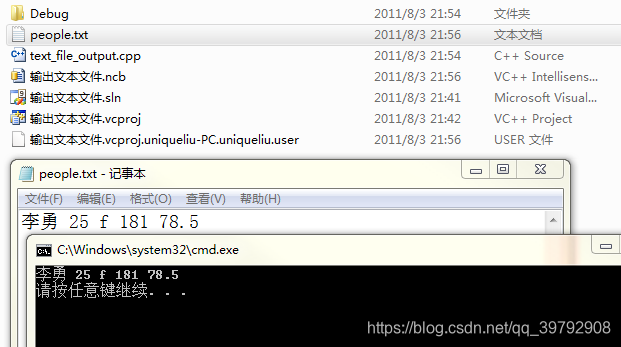转载自**
https://www.cnblogs.com/uniqueliu/archive/2011/08/03/2126680.html
**
什么都不说了,继续《C++学习笔记之对文件的操作<1>》的内容…
=功能展示
打开文件的方式
当我们想要打开的文件不存在的时候,一般地,ofstream类的对象会默认地自动创建一个文件。而如果我们想要打开的文件是存在的,那么就会调用ofstream的构造函数或者是调用open()函数进行打开。下面,我们来看一下MSDN上面是如何定义open()函数的:
首先是函数原型:
void open(const char *_Filename,ios_base::openmode _Mode = ios_base::in | ios_base::out,int _Prot = (int)ios_base::_Openprot
);
void open(const char *_Filename,ios_base::openmode _Mode
);
void open(const wchar_t *_Filename,ios_base::openmode _Mode = ios_base::in | ios_base::out,int _Prot = (int)ios_base::_Openprot
);
void open(const wchar_t *_Filename,ios_base::openmode _Mode
);
接下来是参数的说明:
复制代码
_Filename
The name of the file to open.
打开文件名_Mode
One of the enumerations in ios_base::openmode.
文件的打开方式(在ios_base::openmode中定义)_Prot
The default file opening protection.
默认进行文件打开时的保护
复制代码
OK,我们再来看看ios_base::openmode中定义的打开方式:
复制代码
ios::in, to permit extraction from a stream.
打开文件进行读操作,即读取文件中的数据
ios::out, to permit insertion to a stream.
打开文件进行写操作,即输出数据到文件中
ios::app, to seek to the end of a stream before each insertion.
打开文件之后文件指针指向文件末尾,只能在文件末尾进行数据的写入
ios::ate, to seek to the end of a stream when its controlling object is first created.
打开文件之后文件指针指向文件末尾,但是可以在文件的任何地方进行数据的写入
ios::trunc, to delete contents of an existing file when its controlling object is created.
默认的文件打开方式,若文件已经存在,则清空文件的内容
ios::binary, to read a file as a binary stream, rather than as a text stream.
打开文件为二进制文件,否则为文本文件
复制代码
好了,open()函数的用法全部列举出来了。下面就针对ios_base::binary的二进制打开方式,我们在来谈一谈二进制文件的输出方式和文本文件的输出方式。
① 文本形式输出到文件,我们完全可以在open函数的mode选项中调用
ios::out|ios::app
好了,上面这句话说的就是将数据依次输出。注意,这里用的是依次,原因就是我们采用了app(append)模式,此表示在文件末尾继续写入文件,这就实现了数据的挨个写入 _。一个完整的程序例子如下:
#include <iostream>
#include<fstream>
using namespace std;
const int num=20;
struct people
{char name[num];double weight;int tall;int age;char sex;
};
int main()
{people pe={"李勇",78.5,181,25,'f'};ofstream fout("people.txt",ios::out|ios::app);fout<<pe.name<<" "<<pe.age<<" "<<pe.sex<<" "<<pe.tall<<" "<<pe.weight<<" "<<"\n";fout.close();ifstream fin("people.txt");char ch[255];fin.getline(ch,255-1,0);cout<<ch;fin.close();return 0;
}
输出如下:

我们可以看到,people.txt文件中的内容和命令行中的一样。② 二进制形式输出到文件 为了能够让其用二进制方式输出文件,我们只需要把上面程序的第16行和17行换做
1
2
ofstream fout("people.txt",ios::binary);
fout.write((char*)&pe,sizeof pe);
程序的第1行中的标志binary用于开启二进制模式,第2行调用了write函数。该函数有两个参数,第一个是要写入数据的首地址,在这里是结构体pe的地址,而第二个参数是要写入的字符数目,这里我们用sizeof来计算pe的字符数。具体程序如下:
#include <iostream>
#include<fstream>
using namespace std;
const int num=20;
struct people
{char name[num];double weight;int tall;int age;char sex;
};
int main()
{people pe={"李勇",78.5,181,25,'f'};ofstream fout("people.txt",ios::binary);fout.write((char*)&pe,sizeof pe);fout.close();people pe1={"张玲",65.4,165,62,'m'};ifstream fin("people.txt",ios::binary);fin.read((char*)&pe1,sizeof pe1);cout<<pe1.name<<" "<<pe1.age<<" "<<pe1.sex<<" "<<pe1.tall<<" "<< pe1.weight <<" "<<"\n";fin.close();return 0;
}
我们再来看看这个东东的输出,我们可以看到,以txt文档打开文件时候,会产生乱码。这就是因为txt文件是以文本方式打开的,所以我们看到的都是乱码。如下图:

呼呼,以上就是我自认的自己不是很懂的C++关于如何操作文件的记录,到这里了~~全文完 _
:前端调试之事件伪类练习)



:前端调试之微博头部开发)


)
:前端调试之css装饰cursor)


:前端调试之css装饰cursor练习)



:前端调试之shadow)



:前端调试之事件伪类练习二)